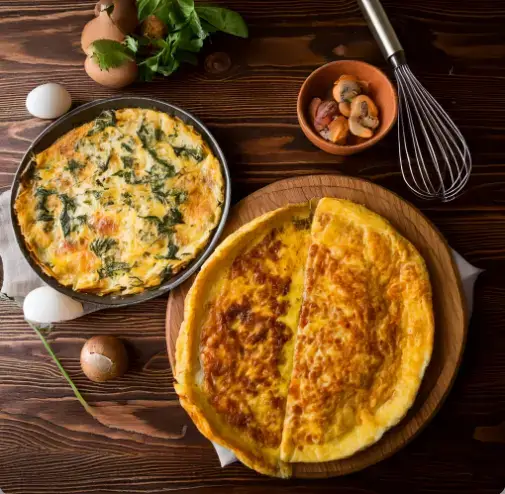Introduction: What’s the Difference Between a Frittata and an Omelette?
Frittatas and omelettes are two of the most beloved egg dishes around the world, often causing confusion for those who are not familiar with their distinct qualities. While both are made with eggs and can be customized with a variety of fillings, the methods of preparation, textures, and serving styles make each dish unique. The frittata is typically slow-cooked in the oven, allowing the eggs to set evenly and creating a hearty, family-friendly dish, whereas the omelette is prepared quickly on the stovetop, resulting in a lighter, individual serving. Understanding these differences will help you decide which dish is best for your next meal, whether you’re looking for a comforting, substantial option to share with others or a speedy, satisfying breakfast for one. Exploring these dishes’ nuances can also open the door to countless variations, making both the frittata and the omelette incredibly versatile and delicious choices for any occasion.
Origins and History: What’s the Difference Between a Frittata and an Omelette in Their Origins?
Both frittatas and omelettes have deep culinary roots, each linked to different culinary traditions.
Frittata: What’s the Difference Between a Frittata and an Omelette in Italian Influence?
The frittata, an iconic Italian dish, evolved from the word fritta, meaning “fried.” Traditionally, Italians made frittatas to use up leftover ingredients, transforming them into a satisfying and delicious meal. The versatility of the frittata—incorporating vegetables, meats, and cheeses—made it an economical and delicious choice for families.
Omelette: What’s the Difference Between a Frittata and an Omelette in French Tradition?
In contrast, the omelette originated in France, where it was refined into a light and elegant dish. Over time, it became a cornerstone of French cuisine and spread globally due to its simplicity and adaptability. French chefs focused on perfecting the technique, aiming for a soft and delicate texture, which has since influenced many variations across the world.
Key Similarities Between a Frittata and an Omelette: What’s the Difference in Common Features?
While these dishes differ in many ways, they also share several important features:
- Egg-Based and Quick: Both dishes are quick to prepare and primarily made with eggs, making them perfect for busy mornings or leisurely brunches.
- Versatile Fillings: Frittatas and omelettes can incorporate a variety of ingredients, such as vegetables, meats, cheeses, and herbs, allowing for endless creativity and customization.
- Adaptable to Any Meal: Whether for breakfast, lunch, or dinner, both dishes can be adapted to fit various occasions, from casual family meals to elegant gatherings.
These similarities provide a foundation for exploring the differences between the two dishes.
What Is a Frittata? Understanding the Italian Classic Dish
The frittata stands out as a hearty and satisfying meal. It’s an excellent option for anyone seeking a substantial, filling dish.
Cooking Style: Stovetop to Oven Approach
A traditional frittata is started on the stovetop, cooking over low heat, and then transferred to the oven for even cooking. This method allows the frittata to develop a firm, fluffy texture. The oven helps to achieve a golden, slightly crispy exterior while maintaining a tender interior.
Serving Style: Family-Style Portions
Frittatas are typically served in wedges, much like a quiche, making them perfect for family-style meals or large gatherings. It’s an ideal dish for potlucks, brunches, or any event where you want to share a hearty meal.
Fillings: A Rich, Cohesive Mix
In a frittata, fillings like cheese, vegetables (such as spinach or mushrooms), and meats (like sausage or bacon) are mixed directly into the egg base before cooking. This method ensures a rich, cohesive flavor and a dense, satisfying texture that makes the frittata perfect for larger meals.
What Is an Omelette? Discovering the French Delight
The omelette, on the other hand, offers a lighter, faster option with a delicate texture.
Cooking Style: Quick Stovetop Method
Omelettes are cooked entirely on the stovetop, typically over medium heat. The eggs cook quickly and develop a soft, creamy texture. The key to making a great omelette lies in controlling the heat and ensuring the eggs cook evenly without becoming tough or rubbery.
Serving Style: Individual Portions
Unlike frittatas, which are sliced and served family-style, omelettes are folded in half, creating a neat and compact serving. This folding technique not only enhances the omelette’s appearance but also ensures the fillings remain tucked inside for a perfectly balanced bite.
Fillings: Layered for Texture
Fillings in omelettes, such as herbs, cheeses, and meats (like ham or bacon), are typically added once the eggs begin to set. This method ensures that the fillings maintain their distinct flavors and textures, while the soft, creamy eggs provide a delicate base for the dish.
Frittata vs. Omelette: A Comparison of Ingredients
While both dishes share similar ingredients, subtle differences in their preparation make each dish unique.
Eggs: The Foundation of Both Dishes
Frittatas use more eggs than omelettes, creating a thicker, more substantial texture. The additional eggs contribute to the frittata’s hearty nature, whereas omelettes are lighter and airier due to fewer eggs.
Dairy: Creaminess and Richness
Frittatas often incorporate cream or milk to create a rich, custard-like consistency. On the other hand, omelettes typically require minimal or no dairy, allowing for a lighter texture that highlights the eggs.
Fillings: Mixed or Layered
In a frittata, the fillings are mixed directly into the egg base, resulting in a dense, cohesive texture. Omelettes, however, feature fillings that are added after the eggs begin to set and are then folded inside, allowing the ingredients to retain their individual flavors and textures.
Cooking Methods: Frittata vs. Omelette
The cooking techniques for these dishes reflect their different textures and serving styles.
Frittata Cooking Method
Start by cooking the frittata on the stovetop over low heat. Once the eggs begin to set, transfer the pan to the oven, where the dish will finish cooking evenly. This method ensures a firm texture that holds together when sliced, perfect for serving in wedges.
Omelette Cooking Method
For an omelette, cook the eggs entirely on the stovetop. Use medium heat to gently cook the eggs, adding fillings as the eggs set. Fold the omelette in half and serve immediately to preserve the soft, creamy texture.
Texture and Consistency: Frittata vs. Omelette
The textures of these dishes are a major point of distinction.
Frittata Texture: Firm and Spongy
Frittatas are thicker and firmer, with a spongy texture that makes them satisfying and filling. The combination of eggs, dairy, and fillings creates a hearty dish perfect for sharing.
Omelette Texture: Soft and Creamy
Omelettes, on the other hand, are soft and creamy, with a light and delicate texture that melts in your mouth. The quick cooking method ensures that the eggs remain tender and slightly custardy, making for a completely different eating experience.
Serving Styles: Frittata vs. Omelette
The way each dish is served further highlights their unique qualities.
Frittata Serving Style
Frittatas are typically served in wedges or slices, making them perfect for group meals. They can be enjoyed both hot and at room temperature, making them great for sharing.
Omelette Serving Style
Omelettes are served folded in half, often as individual portions. Their compact nature makes them ideal for a quick, satisfying meal that’s perfect for busy mornings or light lunches.
Which Dish Is Faster? Frittata vs. Omelette
When it comes to preparation time, omelettes win as the quicker option.
Frittata Cooking Time
Frittatas take longer to prepare, typically requiring 20 to 30 minutes due to the oven step.
Omelette Cooking Time
Omelettes cook much faster, usually taking only 5 to 10 minutes to prepare and cook.
Nutritional Comparison: Frittata vs. Omelette
Nutritionally, both dishes can vary significantly based on the ingredients used.
Frittata Nutrition
Frittatas tend to be higher in calories and fat, especially when made with cream, cheese, or fatty meats. This makes them more indulgent, though they can still be made healthier by using lean proteins and plenty of vegetables.
Omelette Nutrition
Omelettes are generally lighter, especially if made with minimal oil and healthy fillings like vegetables. By omitting or reducing cheese and heavy meats, you can create a lower-calorie dish.
When to Choose a Frittata or an Omelette: Ideal Occasions
Knowing when to serve a frittata or an omelette depends on your needs.
Frittata
Frittatas are perfect for brunches, picnics, or dinner parties when you’re serving a group of people. They also work well as make-ahead dishes.
Omelette
Omelettes are ideal for a quick, individual meal, especially on busy mornings or when you need something fast yet satisfying.
Popular Recipes for Frittatas and Omelettes
Frittata Recipes
- Spinach and feta
- Roasted vegetables
- Ham and cheese
Omelette Recipes
- Classic French omelette
- Cheese and herb omelette
- Mushroom and onion omelette
Common Mistakes to Avoid
To ensure your frittata or omelette turns out perfectly, avoid these common mistakes:
Frittata Mistakes
- Overcooking can make the frittata rubbery.
- Skipping proper seasoning can result in a bland dish.
Omelette Mistakes
- Cooking on high heat can cause the eggs to brown too quickly.
- Overfilling can make it difficult to fold and balance the ingredients.
Conclusion: What’s the Difference Between a Frittata and an Omelette?
Both frittatas and omelettes have their own unique qualities that make them stand out in the culinary world. The frittata is a heartier dish, perfect for serving a group, while the omelette is lighter, quicker, and ideal for an individual meal. Each offers endless possibilities for customization, whether you’re craving a rich, oven-baked meal or a delicate, pan-cooked treat. Understanding the differences between the two will help you choose the best dish for your needs, allowing you to enjoy these egg-based classics in their full glory.
FAQs
What’s the difference between a frittata and an omelette?
A frittata is cooked slowly, often in both the stovetop and oven, creating a thick, hearty texture, while an omelette cooks quickly in a pan, resulting in a light, creamy texture.
Can I use the same ingredients for both dishes?
Yes, both dishes can include similar fillings, but in a frittata, the fillings are mixed into the eggs before cooking, while in an omelette, they’re added once the eggs begin to set.
Which dish is healthier?
Omelettes are generally lighter than frittatas. However, both can be healthy depending on the ingredients used.
Can I make a frittata without an oven?
Yes, you can cook a frittata entirely on the stovetop over low heat, covering the pan to let the eggs set evenly.
Which dish is easier for beginners?
Omelettes are quicker and simpler, making them ideal for beginners.
How do I store leftovers?
Frittatas can be stored for up to three days in the fridge, while omelettes are best eaten fresh but can be stored for one day.

